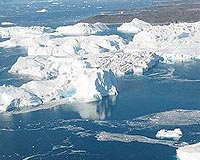| . |  |
. |
Srinagar, India (AFP) Oct 13, 2009 Rising winter temperatures are shrinking Himalayan glaciers in Indian Kashmir at "alarming" speeds, threatening water supplies to vast tracts of India and Pakistan, according to a new study. The Kolahoi glacier, the largest in the region, has shrunk by 2.63 square kilometers (one square mile) in the past three decades to just over 11 square kilometers, said the study presented at a three-day international workshop on climate change that began Monday in the Kashmiri summer capital Srinagar. Himalayan glaciers feed into Asia's nine largest rivers that flow to China, India, Pakistan, Bangladesh and Myanmar. The Kolahoi glacier is shrinking 0.08 square kilometers a year, "which is an alarming speed", said the three-year study led by Shakil Ramsoo, associate professor of geology at Kashmir University. "Other small Kashmir glaciers are also shrinking and the main reason is that the winter temperature in Kashmir is rising," said the study, citing an increase of 1.1 degrees Celsius over the past 100 years. The quantity of snowfall in Kashmir, known as the "Switzerland of the East", has clearly fallen in recent decades. Despite occasional heavy snowfall, the inability of snow to freeze and develop into hard and longer-lasting crystals owing to higher temperatures has resulted in faster meltdown, say experts. "If you talk about Kashmir and you look at the statistics of climate change, it is melting faster here than any other place in the world," said Sally Dotre, an expert from Cambridge University. "And that's going to have a dramatic effect in Kashmir and Pakistan, because it is already affecting water levels," Dotre said. Water levels in almost all the rivers in Indian Kashmir have decreased by two-thirds during the last 40 years. Share This Article With Planet Earth
Related Links Beyond the Ice Age
 Greenland icesheet could melt faster than thought: study
Greenland icesheet could melt faster than thought: studyParis (AFP) Sept 16, 2009 The Greenland icesheet responded to global warming over the past 10,000 years more quickly than thought, according to a study released Wednesday. As a result, a medium-sized temperature increase this century could cause the continent-sized ice block to start melting at an alarming rate, it suggests. "It is entirely possible that a future temperature increase of a few degrees Celsius in ... read more |
|
| The content herein, unless otherwise known to be public domain, are Copyright 1995-2009 - SpaceDaily. AFP and UPI Wire Stories are copyright Agence France-Presse and United Press International. ESA Portal Reports are copyright European Space Agency. All NASA sourced material is public domain. Additional copyrights may apply in whole or part to other bona fide parties. Advertising does not imply endorsement,agreement or approval of any opinions, statements or information provided by SpaceDaily on any Web page published or hosted by SpaceDaily. Privacy Statement |